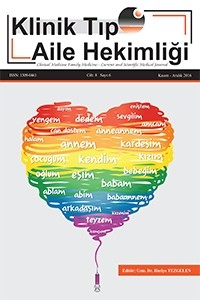İnsülin Tedavisi ve Hipoglisemi Üzerine Yapılan Çalışmalara Güncel Bakış
Diabetes Mellitus, Hipoglisemi, İnsülin tedavisi
Diabetes Mellitus, Hypoglycemia, Insulintherapy,
___
- Kaynaklar 1.Satman I, Omer B, Tutuncu Y, Kalaca S, Gedik S, Dinccag Net al.Twelve year trends in the prevalence and risk factors ofdiabetes and prediabetes in Turkish adults. Eur JEpidemiol.2013;28:169-180 .2.International Diabetes Federation. IDF Diabetes Atlas. (6thed). Brussels, Belgium: International Diabetes Federation;2013;153. 3.The Diabetes Control and Complications Trial Research Gro-up. The effect of intensive treatment of diabetes on the develop-ment and progression of long-term complications in insulin-de-pendent diabetes mellitus. N Engl J Med 1993; 329:977-986. 4.UK Prospective Diabetes Study (UKPDS) Group. Intensiveblood-glucose control with sulphonylureas or insulin compa-red with conventional treatment and risk of complications inpatients with type 2 diabetes (UKPDS 33). Lancet 1998;352:837-853. 5.The Diabetes Control and Complications Trial/Epidemiologyof Diabetes Interventions and Complications (DCCT/EDIC)Study Research Group, Nathan DM, Cleary PA, Backlund JY,Genuth SM, Lachin JM, Orchard TJ et al. Intensive diabetestreatment and cardiovascular disease in patients with type 1diabetes. N Engl J Med 2005; 353:2643-2653. 6.Workgroup on Hypoglycemia. American Diabetes Associati-on. Defining and reporting hypoglycemia in diabetes. Diabe-tes Care 2005; 28:1245-1249. 7.Seaquist ER, Anderson J, Childs B, Cryer P, Dagogo-Jack S,Fish L,et al. Hypoglycemia and diabetes: a report of a workg-roup of the American Diabetes Association and the Endocri-ne Society. Diabetes Care 2013; 36:1384-1395. 8.ACCORD Study Group, Gerstein HC, Miller ME, ByingtonRP, Goff DC, Jr., Bigger JT, Buse JB,et al. Effects of inten-sive glucose lowering in type 2 diabetes. N Engl J Med 2008;358:2545-2559. 9.Finfer S, Chittock DR, Su SY, Blair D, Foster D, Dhingra V,etal. Intensive versus conventional glucose control in criticallyill patients. N Engl J Med 2009; 360:1283-1297. 10.Mellbin LG, Ryden L, Riddle MC, Probstfield J, RosenstockJ, Diaz R, et al.Does hypoglycaemia increase the risk of car-diovascular events? A report from the ORIGIN trial. Eur He-art J 2013; 34:3137-3144. 11.Cryer PE. The barrier of hypoglycemia in diabetes. Diabetes2008; 57:3169-3176. 12.Cryer PE. Hypoglycemia in Diabetes: Pathophysiology,Prevalence and Prevention. 2nd Ed. Alexandria, VA, Ameri-can Diabetes Association, 2013. 13.Matschinsky FM. Regulation of pancreatic beta-cell glucoki-nase: from basics to therapeutics. Diabetes. 2002;51(Suppl3):S394–404. 14.Berson SA, Yalow RS, Bauman A, Rothschild MA, Newerly K.Insulin-I131 metabolism in human subjects: demonstration ofinsulin binding globulin in the circulation of insulin treatedsubjects. The Journal of Clinical Investigation.1956;35:170–190. 15.Yalow RS, Berson SA. Dynamics of Insulin Secretion inHypoglycemia. Diabetes. 1965;14:341–349. 16.Meissner T, Wendel U, Burgard P, Schaetzle S, Mayatepek E.Long-term follow-up of 114 patients with congenital hyperin-sulinism. Eur J Endocrinol (2003) 149(1):43–51.10.1530/eje.0.1490043 17.Rossetti P, Porcellati F, Bolli GB, Fanelli CG. Prevention ofhypoglycemia while achieving good glycemic control in type1 diabetes. Diabetes Care 2008; 31 (Suppl 2):S113-S120. 18.Siebenhofer A, Plank J, Berghold A, Jeitler K, Horvath K, Na-rath M, et al. Short acting insulin analogues versus regularhuman insulin in patients with diabetes mellitus. Cochrane Da-tabase Syst Rev 2006; CD003287. 19.Horvath K, Jeitler K, Berghold A, Ebrahim SH, Gratzer TW,Plank J,et al.Long-acting insulin analogues versus NPH in-sulin (human isophane insulin) for type 2 diabetes mellitus.Cochrane Database Syst Rev 2007; CD005613. 20.Pedersen-Bjergaard U, Kristensen PL, Beck-Nielsen H, Norga-ard K, Perrild H, Christiansen JS,et al. Effect of insulin analo-gues on risk of severe hypoglycaemia in patients with type 1 dia-betes prone to recurrent severe hypoglycaemia (HypoAna Tri-al): a prospective, randomised, open-label, blinded-endpoint cros-sover trial. Lancet Diabetes Endocrinol 2014; 2:553-561. 21.Bay C, Kristensen PL, Pedersen-Bjergaard U, Tarnow L,Thorsteinsson B. Nocturnal continuous glucose monitoring:accuracy and reliability of hypoglycemia detection in patientswith type 1 diabetes at high risk of severe hypoglycemia. Dia-betes Technol Ther 2013; 15:371-377. 22.Polonsky KS, Given BD, Van Cauter E. Twentyfourhour pro-files and pulsatile patterns of insulin secretion in normal andobese subjects. J Clin Invest 1988; 81: 442–448. 23.Brunner GA, Hirschberger S, Sendlhofer G, Wutte A, Ellme-rer M, Balent B, et al Postprandial administration of the in-sulin analogue insulin aspart in patients with type 1 diabetesmellitus. Diabet Med 2000; 17: 371–375. 24.Ratner R, Wynne A, Nakhle S, Brusco O, Vlajnic A, RendellM. Influence of preprandial vs. postprandial insulin glulisi-ne on weight and glycaemic control in patients initiatingbasalbolus regimen for type 2 diabetes: a multicenter, ran-domized, parallel, openlabel study. Diabetes Obes Metab 2011;13: 1142–1148. 25.Slattery D, Amiel SA, Choudhary P.Optimal prandial timingof bolus insulin in diabetes management: a review. Diabet Med.2018 Mar;35(3):306-316. doi: 10.1111/dme.13525. Epub 2017Nov 6.
- ISSN: 1309-0461
- Başlangıç: 2009
- Yayıncı: Selen Medya Yayıncılık Tanıtım ve Organizasyon Hizmetleri
Üniversitesi Öğrencilerinde Güneşten Korunma Bilinci (Toplumsal DuyarlılıkProjesi)
Olgularla Kulak Enfeksiyonları
Dövme Uygulamaları Ne Kadar Güvenli
Kronik Böbrek Hastalığı Olan Çocuklarda Beslenme Desteği
Türkiye’de Özçekim Yaralanma ve Ölümleri
İnsülin Tedavisi ve Hipoglisemi Üzerine Yapılan Çalışmalara Güncel Bakış
Aile Hekimliği Polikliniğinde Hipofizer Gigantizm Tanısı Konulan Bir Olgu
